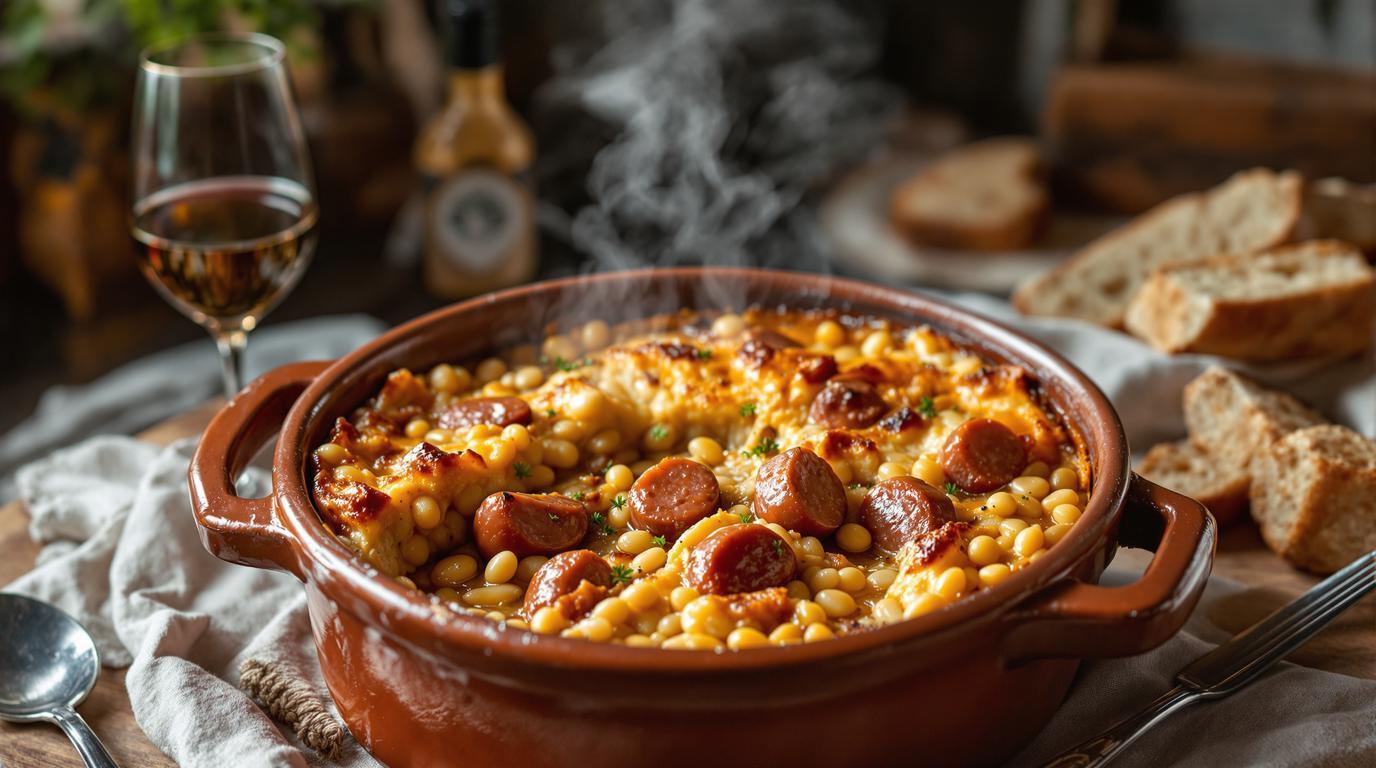The first time I encountered traditional cassoulet, I was staging at a small restaurant outside Toulouse. The head chef—a stern woman with forearms like steel cables—had been tending to her cassoulet for three days. “This isn’t dinner,” she told me, breaking the golden crust for the seventh time that day, “it’s a commitment.” That lesson transformed my approach to slow-cooked dishes forever. True cassoulet requires patience, quality ingredients, and an understanding that some culinary traditions exist for a reason. Let me show you how to create this magnificent bean and meat symphony at home—with all the traditional touches that make it extraordinary.
The Story
Cassoulet Toulousain stands as the crown jewel of Southwest French cuisine—a dish born from necessity that evolved into art. While Castelnaudary and Carcassonne have their versions (heavy on pork and lamb respectively), Toulouse’s rendition, with its duck confit and distinctive sausage, creates a perfect balance between rustic comfort and refined technique. This isn’t just bean stew; it’s a carefully orchestrated marriage of textures and flavors that develops over multiple days of preparation.
When made properly, cassoulet delivers an experience that transcends its humble ingredients: creamy beans with slight resistance, duck that melts on your tongue, and a golden crust that provides the perfect textural contrast. It’s worth every minute of preparation.
Ingredients Spotlight
For 6-8 servings:
- 1 pound (500g) dried Tarbais or cannellini beans, soaked overnight
- 4 duck confit legs (about 1.5kg), homemade or store-bought
- 1 pound (450g) Toulouse sausage (substitute with garlic pork sausage if unavailable)
- 6 oz (170g) salt pork or pork belly, diced
- 2 medium onions, finely diced
- 4 cloves garlic, minced
- 2 carrots, finely diced (optional but adds sweetness)
- 2 tablespoons duck fat or olive oil
- 2 bay leaves
- 3 sprigs fresh thyme
- 5 cups (1.2L) chicken stock or water
- Sea salt and freshly cracked pepper
Step-by-Step Guide
Day 1: Bean Preparation
- Rinse soaked beans thoroughly. Place in a large pot with cold water covering by 2 inches.
- Add 1 halved onion, 2 garlic cloves, bay leaves, and thyme. Bring to a gentle simmer.
- Cook for 60-90 minutes until beans are tender but still hold their shape. Season with salt only in the final 15 minutes of cooking.
- Drain beans, reserving 2 cups of cooking liquid. Remove aromatics.
Day 1: Meat Preparation
- Heat duck fat in a large skillet. Brown the sausages until golden on all sides, then slice into 1-inch pieces.
- In the same fat, brown the salt pork until crispy. Remove and set aside.
- Sauté remaining diced onion and garlic until translucent, about 5 minutes. Add diced carrots if using, cooking for another 3 minutes.
Day 1-2: Assembly and Initial Cooking
- Preheat oven to 300°F (150°C).
- In a deep earthenware cassole or Dutch oven, layer one-third of beans, followed by half the sausage, duck confit, and salt pork.
- Add another third of beans, remaining meats, then top with remaining beans.
- Pour in enough reserved bean liquid and stock to barely cover the beans.
- Bake covered for 1.5 hours. Remove cover, increase heat to 375°F (190°C) and continue baking for 30 minutes until a crust forms.
- Push crust gently into the cassoulet with a spoon. Reduce heat to 300°F (150°C) and continue baking for another hour, breaking and submerging the crust 2-3 more times.
- Cool completely and refrigerate overnight (this deepens flavors dramatically).
Day 2-3: Final Cooking
- Return cassoulet to room temperature, then reheat in a 300°F (150°C) oven for 1 hour.
- Allow a final golden crust to form before serving.
Expert Techniques
The secret to exceptional cassoulet lies in three critical elements: proper bean preparation, layering, and crust development.
For beans, never rush the soaking or cooking. Tarbais beans are traditional because they maintain integrity while absorbing flavor. If substituting, choose beans that hold their shape when cooked.
When layering, be strategic—duck should be placed skin-side up so it continues to render fat throughout cooking, enriching everything around it. Each component should be properly seasoned before assembly.
The crust (or “gratin”) formation is crucial. Breaking it and allowing it to reform multiple times concentrates flavor and creates the characteristic textural contrast that defines great cassoulet. Never skip this step.
Chef’s Note: Traditional cassoulet doesn’t include tomatoes or breadcrumbs. The crust forms naturally from the beans as they cook. If your cassoulet seems too wet after the initial cooking, uncover and cook longer rather than adding thickeners.
Presentation & Pairing Ideas
Serve cassoulet directly from its cooking vessel at the table—it’s meant to be communal. A simple green salad dressed with sharp vinaigrette provides welcome contrast to the richness. Crusty country bread is essential for sopping up the incredible sauce.
For wine, reach for something with enough structure to stand up to the dish. A Madiran from Southwest France works beautifully, as does a Syrah blend. If you prefer white, a rich oak-aged Chardonnay complements the duck fat beautifully.
For a lighter variation, try using magret de canard instead of confit, and reduce the cooking time. Vegetarians might appreciate a mushroom cassoulet using king oyster mushrooms in place of meat—not traditional, but delicious in its own right.
Remember, true cassoulet is about building layers of flavor through time and technique. The result isn’t just a meal—it’s an experience that connects you to centuries of culinary tradition. Make it when you have time to savor not just the eating, but the entire process. Your patience will be rewarded with one of the most satisfying dishes in the French canon.
